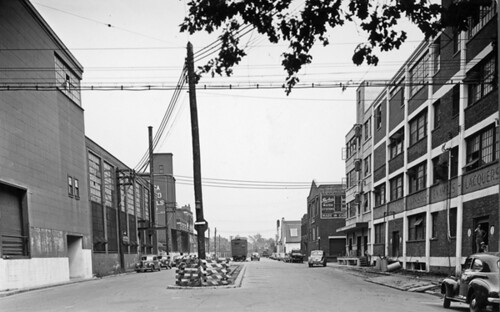
EDITOR’S NOTE: Spacing is pleased to again partner with Heritage Toronto on their ongoing Building Storeys exhibit at the Gladstone Hotel that has been extended until April 25. A collaborative effort by Heritage Toronto and members of the photography groups the Shadow Collective and the DK Photo Group, Building Storeys is a visual documentation and anecdotal exhibit of the city’s heritage building and sites. This is the second in a series of posts on Spacing Toronto connected to the exhibit, and is by David Wencer. Above photo: Wabash Avenue looking east from Sorauren, 1947. The Canada Linseed Oil Mills can be seen on the left side of the street, a few buildings in. Note the rail siding down the centre of Wabash. (City of Toronto Archives/TTC Fonds, Series 71, Item 15831)
The Canada Linseed Oil Mills buildings have been standing on Wabash Avenue for nearly one hundred years. For forty of these years, they have been vacant. Industry’s gradual exodus from the surrounding area has been steady; several nearby buildings which once employed local residents and made products for the community have been retrofitted and reborn as condos or artist’s studios, while other buildings have been torn down completely and placed with new city infrastructure. The Canada Linseed Oil Mills structures have yet to undergo this rebirth, but they have certainly not been forgotten.
Shortly after the turn of the 20th Century, a manufacturing area grew along Sorauren Avenue, just south of Dundas Street. Industry was spurred all along the Canadian Pacific Railway lines lying to the immediate east, which over the years belonged to several railroads including the Credit Valley Railway and the Toronto, Grey and Bruce. The strip along Sorauren was also just south of a major rail junction, near where Annette, Dundas & Dupont streets all come together. From this lucrative location at the northern tip of Parkdale, an industry could easily connect by rail with all of southern Ontario.
In the spring of 1910, the Montreal-based Canada Linseed Oil Mills, Ltd. began construction of a new facility on Wabash Avenue, just east of Sorauren. They were joining an industrial community which already included Chapman Double Ball Bearing, leather goods manufacturer Winnett & Wellinger, candy manufacturer Robert Watson, and the Dominion Bridge Company, the latter of which would later manufacture parts for, amongst other Toronto projects, the Prince Edward Viaduct.
In 1910, linseed oil was a thriving industry. Derived from flax seed, linseed oil was then a valuable commodity due to its many applications. Linseed oil was used as a binder in oil paints, especially appreciated for its slow drying time. It was also a valuable water-proofing agent in canvas, and it was popularly employed as a wood finish and used as an ingredient in varnishes. Just one year after the establishment of Canada Linseed Oil Mills in Toronto, the paint (and later varnish) manufacturers Lowe Brothers established themselves just across the street on the south side of Wabash; it is reasonable to presume that the proximity of a linseed oil supplier influenced their choice of location.
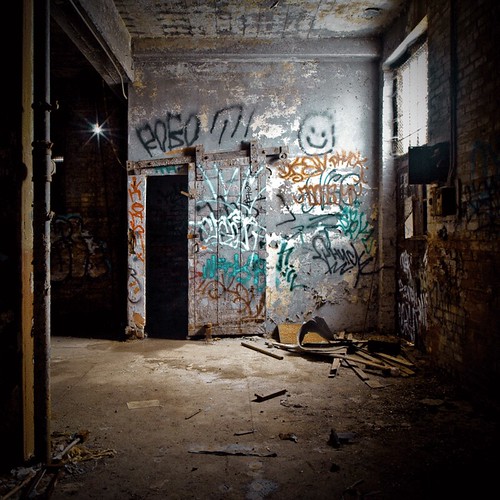
Photo by: Toni Wallachy.
Linseed oil was also used in the manufacture of linoleum (to which it lent its name), and was a key ingredient in oilcloth, a popular pre-cursor to vinyl, with many applications ranging from tents to tablecloths. From at least 1921 into the late 1960s, the presidents of Canada Linseed Oil Mills also acted as managing director of Dominion Oil Cloth & Linoleum, suggesting that the two companies were financially connected.
Not limited to industrial manufacturing, linseed oil was also used as an edible product; Linseed Oil Cake Meal was produced by the Canada Linseed Oil Mills as a livestock feed, where it was believed to both aid in digestion and improve an animal’s coat. In fact, the company published an instructive booklet on animal feeding for farmers, called “Successful Feeding,” which explains how to incorporate oil cake meal into the diet of farm animals.

The Canada Linseed Oil Mills’ buildings, as depicted in their booklet “Successful Feeding.” The three structures on the right are still standing, including the smokestack.
Linseed oil also found its way into the mouths of humans. Advertisements can be found in the Toronto Star in the 1910s for “Dr. Chase’s Syrup of Linseed and Turpentine,” marketed as a cure for the common cold, bronchitis and asthma. The National Drug and Chemical Company similarly marketed a syrup of Linseed, Licorice and Chlorodyne as “the safe cough syrup for your little ones” (chlorodyne was a then-popular tincture of laudanum, cannabis and chloroform). Without irony, these advertisements appeared in the same years linseed oil was suggested in the women’s pages as a popular home furniture polish and carpet cleaner.
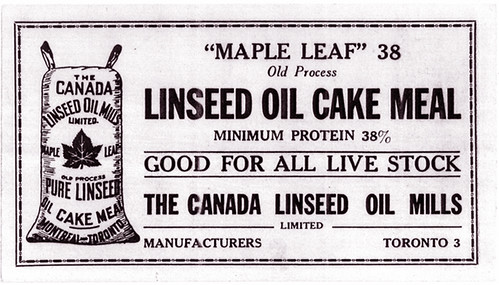
Promotional ink blotter for the Canada Linseed Oil Mills. When fountain pens were popular, it was not uncommon for companies to use ink blotters to advertise, much in the way they use custom fridge magnets or ballpoint pens today. (City of Toronto Archives, Fonds 70, Series 470, Sub-series 2, File 7)
With the popularity of linseed oil at its peak, Canada Linseed Oil Mills selected their site along the rail corridor on the north side of Wabash Avenue, just east of the Dominion Bridge works. The initial Oil Mills buildings on Wabash were designed by architects Langley and Howland, who are credited with many Toronto buildings in the early 20th Century, including Deer Park Public School and eight branches of the Imperial Bank. A notice in the Toronto Star says contracts were given to the Leach Concrete Company for the reinforced concrete construction, and C.W. Wood for the brickwork. The same notice mentions that J.H. Tromanhauser was given the contract for the grain elevator, which “will be absolutely fireproof, thus doing away with the necessity of insuring contents. This is the first type of elevator to be erected in this city.” Fireproofing was vital in buildings designed to manufacture highly-flammable oil.
Over the ensuing decades, the Canada Linseed Oil Mills buildings underwent several alterations, mostly expansions.
While several nearby businesses came and went during Canada Linseed Oil Mills’ tenure, most of the main industries remained unchanged along Sorauren until World War Two. The first significant change to the area was the departure of next-door neighbour Dominion Bridge, located on the northeast corner of Sorauren and Wabash. It is believed that production at Dominion Bridge was changed during the war to manufacture munitions, and that afterwards Dominion Bridge chose to renew operations at other facilities. The TTC acquired the old property, and used the site as both a bus garage and machine shop.
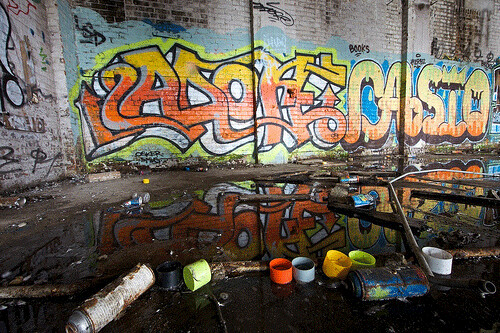
Photo by Mathew Merrett.
Canada Linseed Oil Mills itself appears to have closed its Toronto operations in 1969, likely precipitated by a gradual decline in the popularity of linseed oil. Although still noted as a wood finish, cheaper or more efficient alternatives to linseed oil have been found for many of its industrial uses, and its domestic use has dropped considerably. A few years before its closure, one building on the site was occupied by the Dominion Oil Cloth and Linoleum Company, perhaps offering a clue to the company’s fate. Shortly thereafter Dominion Oil Cloth and Linoleum changed its name to Domco Industries. In March of 1970, an article in the Globe and Mail stated that Domco was negotiating the sale of Canlin Limited, formerly known as the Canada Linseed Oil Mills, and expected the sale to be completed in April.
Since 1970, then, the buildings have remained vacant, and have gradually become a popular destination for vandals and urban photographers alike.
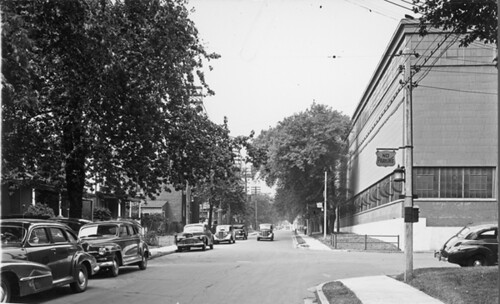
Sorauren Avenue, looking north from Wabash, 1947. At the time that this photo was taken, the property on the right was about to become the TTC’s Parkdale garage. It is now the site of Sorauren Avenue Park. (City of Toronto Archives/TTC Fonds, Series 71, Item 15830)
The TTC site next door was vacated in the 1980s, and efforts began to have that property established as a new community park. After several years of wrangling, this park became a reality in 1995 after the old TTC facilities were demolished, and Sorauren Avenue Park opened atop the site’s old concrete foundation (this unusual arrangement allows for poor drainage, and explains the difficulties of getting plants to grow in the space). The Canada Linseed Oil Mills buildings remain next door, a hollowed-out industrial shell; The Wabash Building Society was formed in 2006, with a long-term of plan of turning these buildings into a community centre.
The Oil Mills site was purchased by the City for $2 million dollars in 2000, and efforts were subsequently taken to decontaminate the soil and remove the asbestos fire-proofing. The hope amongst the project’s supporters is that the linseed oil plant which once employed local residents and helped make dozens of domestic products can one day again benefit the community, this time in the form of public space. As of 2010 this has yet to happen, and the Wabash Building Society website describes the plant as “[looming] over the park like a promise waiting to be fulfilled.”
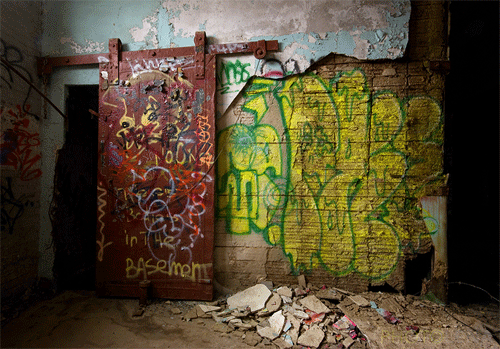
Photo by Olena Sullivan.
Over the last forty years, Sorauren Avenue has changed considerably, with most of the old industries leaving the immediate area. Part of the rail corridor which once connected the local businesses to their suppliers and buyers is now becoming the Railpath which, when completed, will connect bicyclists in Toronto’s west end to the downtown core. The corridor will also soon be re-used by Metrolinx, which hopes to run 400 passengers trains a day along this line, ferrying people along the route which, one hundred years ago, was used to transport supplies and goods. While the prospect of 400 daily diesel trains cannot possibly sit well with the local residents who fought to establish (and continue to fight to improve) Sorauren Avenue Park, it does at least reflect the same creative re-use of infrastructure that the neighbourhood has been championing. Many of the old industrial buildings along Sorauren have found new life in a way that benefits the community, either as homes, new businesses, or in the case of the Dominion Bridge site / TTC Garage, a public park. For the time being, however, the Canada Linseed Oil Mills property remains fenced off and closed to the general public, serving no use to the community other than as a reminder of the area’s industrial heritage.
David Wencer is a historian and heritage advocate based in Toronto’s Junction neighbourhood, where he was actively involved in the community’s 2008-2009 centennial celebrations. He researches and writes on a number of subjects dealing with Toronto history, and contributes regularly to the Heritage Toronto blog and the West Toronto Junction Historical Society’s newsletter, The Leader and Recoder. He also serves on the Etobicoke York Community Preservation Panel, and represents the Panel on Heritage Toronto’s Conservation Committee.




6 comments
The province should consider the health of these great urban neighbourhoods when expanding train services to hundreds per day. The technology is has been available for about a century now to keep the air clean and reduce the noise.
The soil along this corridor is finally being cleaned in time for Metrolinx to and SNC Lavlin to pollute it again with obsolete diesel pollution. Think about it, our tax dollars are being spent to construct a private for profit airport link that has only 2 stops along the way but will pollute the entire west end. Its like the linseed people never left.
Given the number of faux lofts being built in the city, wouldn’t a real loft like this building, keeping its original character, in a great neighbourhood, be a viable concern?
AR: If you read up the the projections for the number of trains, they’re the expected levels for 20 years from now – well after the lines are planned to be electrified. Running more diesels is an interim plan (electrifying takes time), which is much better than the equivalent number of cars on the road.
I understand Christopher, but we need a real commitment from the province that electrification will happen, as well as a funding plan. It’s all well and good that cars will come off the roads, but it can’t translate into a high concentration of pollution and noise in a densely populated area.
David, thank you for this wonderful article. I’ve been involved with Sorauren Park and the Wabash Building Society for many years and this is the best article I’ve read that encapsulates all the history. I’ll be using it for sure on our Jane’s Walk on May 2 at 1 pm starting at Sorauren Park:
http://janeswalk.net/walks/view/sorauren-wabash_railway_loop/